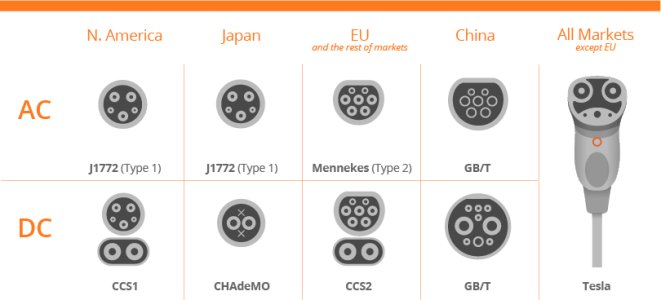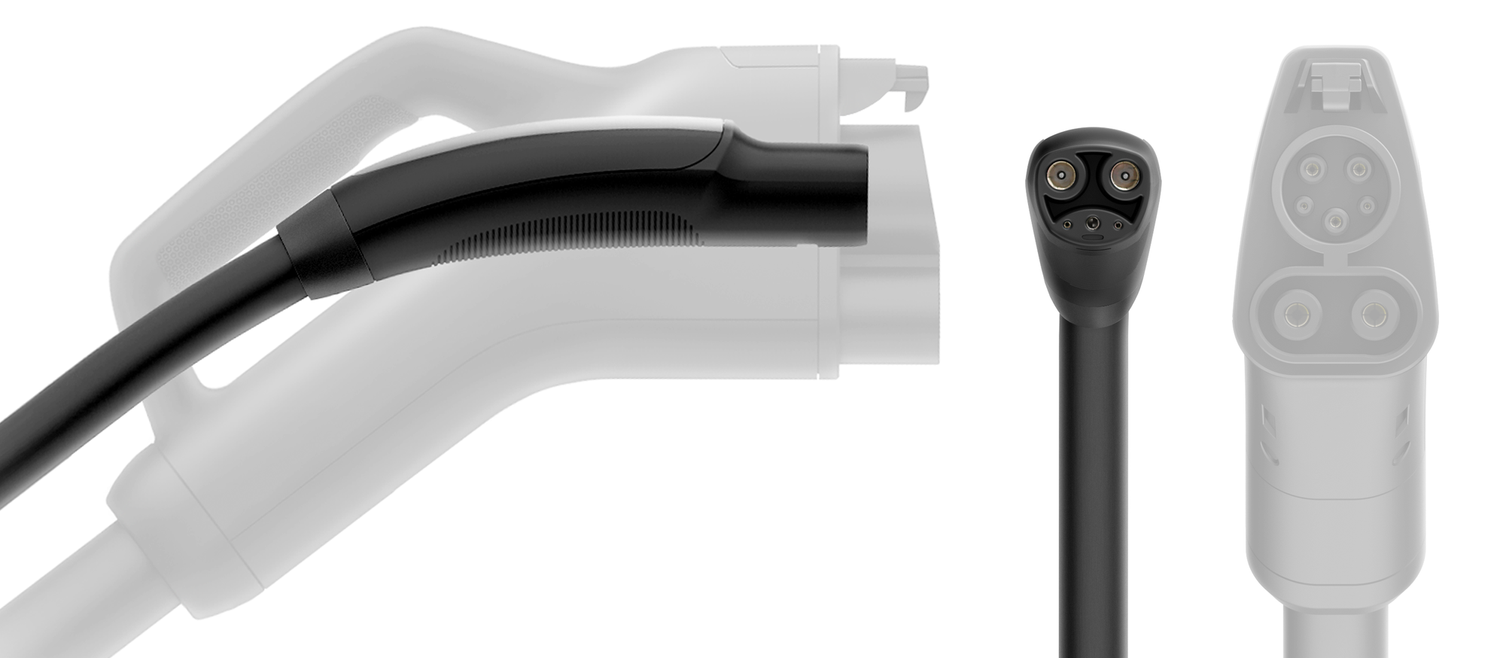J1772 type please. People are already using this and investing in this type of Level 2 charger. Please don't try to reinvent the wheel or be special. Sometimes mainstream is that way for a reason.
Mahalo.
Mahalo.
Last edited:
I agree. However, the Tesla style is very good and simpler. It has also proven to be cable if way more power than is currently available. With that said, I doubt VW would adopt the Tesla style.J1779 type please. People are already using this and investing in this type of Level 2 charger. Please don't try to reinvent the wheel or be special. Sometimes mainstream is that way for a reason.
Mahalo.
But.... tesla.VW owns Electrify America. They're not going to make a different plug for a single brand in their lineup when every charger they own runs a standard plug.
Correct to assume you meant J1772? This is industry std in North America at this point for all but Tesla and very few smaller battery ChADeMO applications. Difficult to image them doing anything other than J1772J1779 type please. People are already using this and investing in this type of Level 2 charger. Please don't try to reinvent the wheel or be special. Sometimes mainstream is that way for a reason.
Mahalo.
Damn! Yup, sure did. Great correction good sir!Correct to assume you meant J1772? This is industry std in North America at this point for all but Tesla and very few smaller battery ChADeMO applications. Difficult to image them doing anything other than J1772
I know you are saying J1772 but the actual connection would be CCS1. CCS1 has the additional inputs for DC Fast charging. J1772 will get level 2, CCS1 gets the Level 3.J1772 type please. People are already using this and investing in this type of Level 2 charger. Please don't try to reinvent the wheel or be special. Sometimes mainstream is that way for a reason.
Mahalo.
Interesting.I know you are saying J1772 but the actual connection would be CCS1. CCS1 has the additional inputs for DC Fast charging. J1772 will get level 2, CCS1 gets the Level 3.
Interesting.
So the CCS1 has the addtional 2 ports for DC on the bottom, supporting L3 charging. The only issue with this is those who have a J1772 only, like me, wouldn't be able to use the CCS1 charger on my J1772 rig. Kinda a pain.

I think you misunderstood. I have a Jeep Wrangler 4xe. So if I were to install a male CCS1 charger, it would not be able to charge my Jeep, as the bottom DC ports would interfere with it plugging in.View attachment 485
That's not true, the J1772 is the same as the top portion of the CCS1. So a J1772 Plugs into the CCS1 for AC charging.
If you have ever been to a location that has a free charger it is typically a J1772. All CCS1 vehicle (id4, ev6, etc) can plug in no issue. All other styles (Tesla/chademo/etc) can plug in with the use of an adapter
Ah I understand you now. The reason a jeep 4xe has only a J1772 is because it's battery is small and cannot handle nor does it need DC fast charging. J1772 cannot handle as much charging speed as a CCS1. Which is why it is most likely the CCS1 port that will be on a Scout. But you can still use the J1772 to plug into a CCS1 and charge at level 1 and level 2I think you misunderstood. I have a Jeep Wrangler 4xe. So if I were to install a male CCS1 charger, it would not be able to charge my Jeep, as the bottom DC ports would interfere with it plugging in.
Correct, yeah I understood that.Ah I understand you now. The reason a jeep 4xe has only a J1772 is because it's battery is small and cannot handle nor does it need DC fast charging. J1772 cannot handle as much charging speed as a CCS1. Which is why it is most likely the CCS1 port that will be on a Scout. But you can still use the J1772 to plug into a CCS1 and charge at level 1 and level 2
Where are you getting a hard wired J1772? in your home? if you get a J1772 hard wired wired in your home then that 100% will work with a Scout that has a CCS1. Nobody does DC charging in their home because all homes run on AC power.Correct, yeah I understood that.
But it's not kinda a thought in my head, where I was wanting to get a hardwired Lvl 2 J1772 charger for the Jeep, now I might have to rethink that if the Scout is going to have the CCS1.
I would assume though that the CCS1 charger, if hardwired at home, would have a converter to DC to facilitate Lvl 3 charging... is this incorrect?Where are you getting a hard wired J1772? in your home? if you get a J1772 hard wired wired in your home then that 100% will work with a Scout that has a CCS1. Nobody does DC charging in their home because all homes run on AC power.
I'm sure if you really wanted to you could buy some equipment to facilitate Lvl 3 charging at your house...so it is possible but is is very much unnecessary and likely super expensive.I would assume though that the CCS1 charger, if hardwired at home, would have a converter to DC to facilitate Lvl 3 charging... is this incorrect?
You are knowledgable, so you know that it is as much about efficiency, as total battery size considering a constant daily commute. The underlying assumption is that larger vehicle will be less efficient, thus require more battery to go a fixed distance vs a smaller more efficient car. I am still holding out hope for Scout efficiency to be equal or better than Rivian.I'm sure if you really wanted to you could buy some equipment to facilitate Lvl 3 charging at your house...so it is possible but is is very much unnecessary and likely super expensive.
just for reference i use level 1 charging for my Tesla model 3. I have been doing that for the last 2 years. So basically I'm charging at 110v, 12A. I gain roughly 1% of battery every hour I charge(equates to ~3miles of range per hour). When i used to work in the office (i teleworking now) i would drive 44 miles round trip. That would drain roughly ~14% of the battery every day. I get home at 4pm then plug in. I didn't leave for work until 6am the next morning which means i would have a full 14 hours of charging. So in a perfect world I broke even, but If i went out for lunch or did some errands that is all extra range i lost. On average i would finish the work week with 10-30% missing off my maximum charge. However we usually didn't drive much on the weekend or if we did we used my wife's ICE car. So by Monday my car was fully charged and ready.
Of course this is all not idea. If i upgraded and got a level 2 charger in my house that would change to 220v, 50a. This would charge the car at roughly 10% per hour. This is more than sufficient for daily use. Given my situation of driving 44 miles for work each day that means i would re-gain my charge from 1.5 hours of charging and more than able to handle any errands or other things that might happen in a normal day.
Level 3 Charging is really meant for road trips. The last time I did a road trip i would charged my Tesla at a 250kW charger. I would charge from 20% to 80% in about 20 minutes. it is extremely fast and also not good for the battery to be done too often.
The main benefit about home charging is most of the time when you are home you will get around 8 hours of sleep and maybe at least another hour for dinner and another for breakfast. So any given night most cars are just sitting for 10 hours a day. At level 2 charging speeds that is enough to charge a battery to 100% every night.
Granted a Scout's battery will likely be bigger than a tesla model 3's (83kw) and be more likely similar to a Rivian (135kW) so the math is a little off but still well within the range of a level 2 charger and for normal daily use.
I think it is fairly safe to assume that the rivian and the scout will share many of the same characteristics because I'm going to assume they will be a similar boxy shape and they will be roughly the same size. One of the big differences will be the make up or the batteries. Rivian uses cylindrical cells like Tesla and scout is likely to use pouch style prismatic cells that VW group prefers.You are knowledgable, so you know that it is as much about efficiency, as total battery size considering a constant daily commute. The underlying assumption is that larger vehicle will be less efficient, thus require more battery to go a fixed distance vs a smaller more efficient car. I am still holding out hope for Scout efficiency to be equal or better than Rivian.

After dealing with both on cars I’ve owned I have to say Tesla gets this right. Way better than J1772. But, I doubt we will win this one.Personally, I'd really like to see Tesla's NACS really become the "standard," and on my brand new Scout II!

